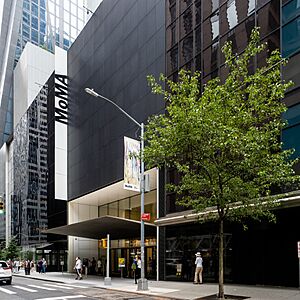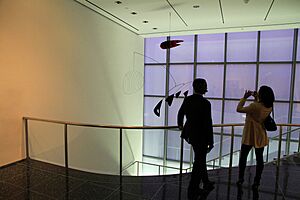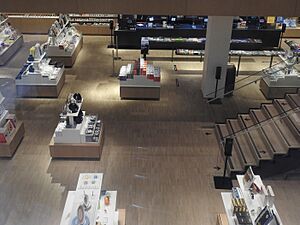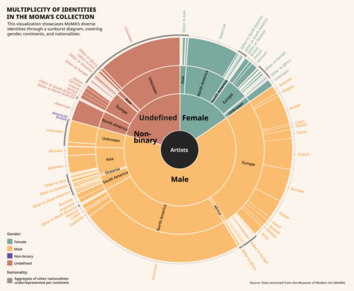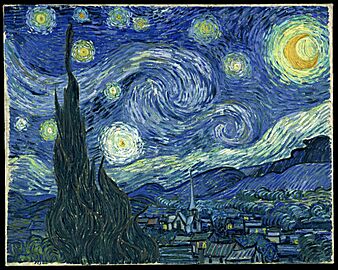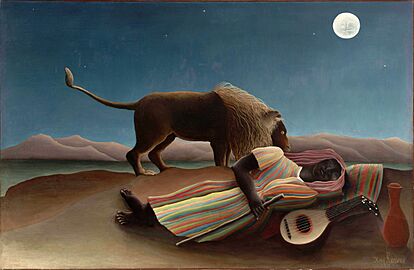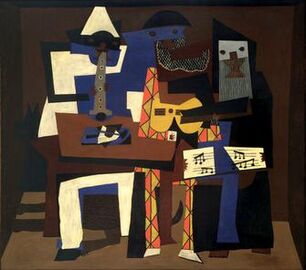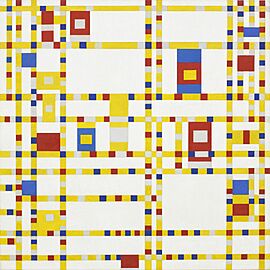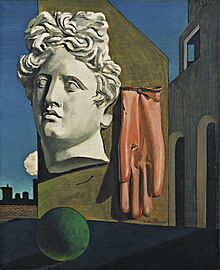Museum of Modern Art facts for kids
 |
|

The Museum of Modern Art in New York City
|
|
| Established | November 7, 1929 |
|---|---|
| Location | 11 West 53rd Street Manhattan, New York City, U.S. |
| Type | Art museum |
| Visitors | 2,839,509 (2023) |
| Public transit access | Subway: Fifth Avenue/53rd Street ( Bus: M1, M2, M3, M4, M5, M7, M10, M20, M50, M104 |
The Museum of Modern Art (MoMA) is a famous art museum in New York City. It's located in Midtown Manhattan on 53rd Street. MoMA is known for its amazing collection of art from the late 1800s to today. This includes over 200,000 pieces of architecture, design, painting, sculpture, photography, and film.
MoMA was started in 1929 by three friends: Abby Aldrich Rockefeller, Lillie P. Bliss, and Mary Quinn Sullivan. It opened just after the Wall Street Crash of 1929. The museum quickly grew its collection under its first director, Alfred H. Barr Jr.. Today, MoMA is one of the most-visited art museums in the world. In 2023, over 2.8 million people explored its galleries.
Contents
MoMA's Beginnings (1929–1939)
The idea for MoMA came from Abby Aldrich Rockefeller and her two friends in 1929. They were sometimes called "the Ladies." They found a small space in the Heckscher Building in Manhattan. The museum opened on November 7, 1929. This was just nine days after a big stock market crash.
Anson Goodyear became the first president of the new museum. Abby Rockefeller was the treasurer. MoMA was the first museum in America focused only on modern art. It was also the first in Manhattan to show European modern art. Soichi Sunami, a famous Japanese-American photographer, worked for the museum from 1930 to 1968. He took pictures of the art and events.
Goodyear asked Paul J. Sachs to suggest a director. Sachs recommended Alfred H. Barr Jr., a talented young expert. Under Barr, the museum's collection grew fast. It started with just eight prints and one drawing. Its first show in 1929 featured paintings by Vincent van Gogh, Paul Gauguin, Paul Cézanne, and Georges Seurat.
MoMA moved several times in its first 10 years. Abby Rockefeller's husband, John D. Rockefeller Jr., didn't like modern art at first. He didn't want to give money for the museum. But later, he donated the land for MoMA's current home. He became one of its biggest supporters. Barr made MoMA special by creating departments for photography and film. This was a new idea for museums.
In 1935, MoMA held a very popular show of Vincent van Gogh's work. It had 66 oil paintings and 50 drawings. This show helped people love Van Gogh's art even more.
Growing Through the Years (1930s to 1950s)
MoMA became famous around the world with a huge Pablo Picasso show in 1939–40. This show helped art experts understand Picasso's work in new ways. Barr, who loved Picasso, planned the whole show. It showed Picasso as the greatest artist of his time.
In 1939, Nelson Rockefeller, Abby Rockefeller's son, became the museum's president. He was 30 years old. He helped MoMA get a lot of attention and money. He also helped it expand into its new building on 53rd Street. His brother, David Rockefeller, joined the board in 1948. He became president when Nelson became governor in 1958.
David Rockefeller hired architect Philip Johnson to redesign the museum garden. He named it the Abby Aldrich Rockefeller Sculpture Garden to honor his mother. The Rockefeller family has always been closely involved with MoMA.
In 1937, MoMA moved its offices to the Time-Life Building. Its permanent home, designed by Philip L. Goodwin and Edward Durell Stone, opened on May 10, 1939. President Franklin D. Roosevelt even gave an opening speech on the radio.
In 1958, a glass front was added to the second floor of the MoMA building. It looked out over the sculpture garden.
The 1958 Fire
On April 15, 1958, a fire broke out on the second floor. It destroyed a large Claude Monet painting called Water Lilies. The fire started when workers were installing air conditioning. They were smoking near paint cans and sawdust. One worker died, and several firefighters were hurt.
Most paintings had been moved, but large ones like the Monet were still there. Art from higher floors was moved to a nearby museum. Visitors and staff stuck above the fire went to the roof. Then they jumped to the roof of a house next door to escape.
Modern Expansions (1960s to Today)
In 1971, Richard Hunt became the first African American sculptor to have a major solo show at MoMA. This happened after protests asking for more Black artists to be included.
In 1983, MoMA made its gallery space twice as big. It also added an auditorium, restaurants, and a bookstore. Architect César Pelli led this expansion. Even with these changes, MoMA's space struggled to hold its growing art collection.
In 1984, a group of 400 women artists protested outside MoMA. They were upset because very few women artists were in a big new exhibition. Only 14 out of 165 artists in the show were women.
Renovations in the 1990s and 2000s
By the late 1990s, MoMA had 100,000 art pieces. In 1997, the museum started planning a big renovation. Japanese architect Yoshio Taniguchi was chosen for the project. The plan almost doubled the space for MoMA's shows and programs.
In 2000, MoMA officially joined with the P.S. 1 Contemporary Art Center. This center was an independent art group in Long Island City, Queens. The Queens location stayed open as an experimental art space. It also served as MoMA's temporary home while the main building was closed for renovations.
MoMA closed its Midtown building completely in May 2002. It moved its public shows to MoMA QNS in Queens. The whole project, including money for running the museum, cost $858 million. The renovation of the Midtown building alone cost $425 million. MoMA reopened on November 20, 2004.
Recent Changes (2010s to Present)
In 2010, MoMA finished its merger with the P.S. 1 Contemporary Art Center. It was officially renamed MoMA PS1.
In 2011, MoMA bought the building next door that housed the American Folk Art Museum. In 2014, MoMA decided to tear down this building. This decision caused some debate because the building was quite new. MoMA went ahead with the demolition to make way for its planned expansion. This expansion included new gallery space within a skyscraper called 53W53.
The architecture firm Diller Scofidio + Renfro worked on MoMA's expansion plans. In June 2017, the first part of the $450 million expansion was finished. This added 15,000 square feet of new galleries. It also included a new gift shop, a redesigned cafe, and two new lounges.
The expansion increased the public space by 25%. This allowed MoMA to show even more of its nearly 200,000 artworks. The goal was also to show more art by women, Latinos, Black artists, Asians, and other groups. MoMA also changed how it displayed art. Instead of separating art by type (like painting or design), it now shows all types of art together in time order.
MoMA closed for more renovations from June to October 2019. When it reopened on October 21, 2019, it had added 47,000 square feet of gallery space. This brought its total area to 708,000 square feet.
Exhibition Houses
MoMA has sometimes shown temporary exhibition houses. These houses have presented important ideas in architecture.
- 1949: House by Marcel Breuer
- 1950: House by Gregory Ain
- 1955: Japanese Exhibition House by Junzo Yoshimura. This house was later moved to Philadelphia.
- 2008: Prefabricated houses by several architects.
Art Collections
MoMA has six main departments for its collections: Architecture and Design, Drawings and Prints, Film, Media and Performance, Painting and Sculpture, and Photography.
MoMA's collection has over 150,000 individual art pieces. It also has about 22,000 films and 4 million film stills. Some of the most famous works include:
- Pablo Picasso's Les Demoiselles d'Avignon
- Vincent van Gogh's The Starry Night
- Claude Monet's Water Lilies
- Andy Warhol's Campbell's Soup Cans
- Salvador Dalí's The Persistence of Memory
- Frida Kahlo's Self-Portrait With Cropped Hair
- Jackson Pollock's One: Number 31, 1950
- Henri Matisse's The Dance
Collection Highlights
-
Vincent van Gogh, The Starry Night, 1889
-
Henri Rousseau, The Sleeping Gypsy, 1897
-
Henri Matisse, The Dance I, 1909
-
Pablo Picasso, Three Musicians, 1921
-
Piet Mondrian, Broadway Boogie Woogie, 1942–1943
-
Giorgio de Chirico, Love Song, 1914
MoMA also has works by many other important artists. These include Auguste Rodin, Georges Braque, Joan Miró, Marcel Duchamp, Georgia O'Keeffe, Edward Hopper, Jackson Pollock, Mark Rothko, and Roy Lichtenstein.
Photography Collection
The MoMA photography collection has over 25,000 works. It is considered one of the most important in the world.
The Photography Department started in 1940. Edward Steichen (curator from 1947–1961) built a famous collection. His most well-known show was The Family of Man. Nine million people saw it. In 2003, this collection was added to UNESCO's Memory of the World Register. This recognized its historical value.
John Szarkowski (curator from 1962–1991) led the department after Steichen. He created shows like "New Documents" in 1967. This show featured photos by Diane Arbus, Lee Friedlander, and Garry Winogrand. It showed a new style of photography that looked more like casual snapshots.
Film Collection
In 1932, MoMA's first director, Alfred Barr, said that film was "the only great art form of the 20th century." He wanted the public to appreciate good films. John Hay Whitney, a museum trustee and film producer, became the first chairman of the Film Library in 1935.
Iris Barry, a British film critic, was the first curator of the film library. She and others built a collection of about 8,000 films. In 1937, the Academy of Motion Pictures Arts and Sciences praised MoMA. They gave the museum an award for collecting films and helping the public study film history.
The film collection now has over 25,000 titles. It is one of the best museum archives of international film art. It includes famous movies like Citizen Kane and Vertigo. It also has unique pieces like Andy Warhol's eight-hour film Empire.
MoMA Library
The MoMA library is in Midtown Manhattan. It has a huge collection of books, magazines, and files about modern and contemporary art. This includes art from 1880 to today. The collection has 300,000 books, 1,000 magazines, and 40,000 files about artists. It also has over 11,000 artist books.
The library is open to researchers by appointment. Its catalog is called "Dadabase." This catalog lists all the materials in the library.
Architecture and Design
MoMA's Department of Architecture and Design started in 1932. It was the first museum department in the world to focus on both architecture and design. Philip Johnson was its first director.
The collection has 28,000 works. These include architectural models, drawings, and photos. It has works by famous architects and designers like Frank Lloyd Wright, the Eameses, and Isamu Noguchi. The design collection also has many industrial items. These range from a ball bearing to a Bell 47D1 helicopter. In 2012, the department started collecting video games. It plans to have 40 games, from Pac-Man (1980) to Minecraft (2011).
Museum Management
MoMA is a private, non-profit organization. It is one of the largest U.S. museums by budget. Its yearly income is about $145 million. The museum does not rely on government funding. Instead, it gets money from many different sources.
MoMA charges an admission fee of $30 for adults. However, New York State residents can visit for free every Friday evening. Many college students in the New York area also get free admission.
MoMA closed in March 2020 because of the COVID-19 pandemic in New York City. In April 2020, it had to let go of its art educators. In May 2020, MoMA announced it would reduce its yearly budget. It also reduced its staff from about 960 to 800 people.
Art Repatriation
MoMA has been involved in some cases about artworks lost during The Holocaust. These artworks ended up in the museum's collection.
In 2009, the family of German artist George Grosz asked for three of his works back. Also, the family of Paul von Mendelssohn-Bartholdy asked for Pablo Picasso's painting Boy Leading a Horse (1905–1906) back. This painting was donated to MoMA in 1964. The family said it was sold unfairly in the 1930s. MoMA and the Solomon R. Guggenheim Museum settled with the families in 2009. They kept the paintings but avoided a long court case.
In 2015, after a long court battle, MoMA returned a painting called Sand Hills by Ernst Ludwig Kirchner. This painting belonged to the Fischer family, who left Germany in 1935.
In 2021, MoMA secretly returned Marc Chagall's Over Vitebsk to the family of Franz Matthiesen. The museum also paid $4 million. The painting's history was unclear. MoMA first thought the sale was not a problem. But later, the museum changed its mind.
Key People at MoMA
MoMA is run by a board of trustees. This board includes 46 trustees and 15 life trustees. They help guide the museum and make important decisions.
Directors of MoMA
- Alfred H. Barr Jr. (1929–1943)
- Rene d'Harnoncourt (1949–1968)
- Bates Lowry (1968–1969)
- John Brantley Hightower (1970–1972)
- Richard Oldenburg (1972–1994)
- Glenn D. Lowry (1995–2025)
- Christophe Cherix (starting 2025)
Chief Curators
Chief curators are experts who manage the art collections in different departments.
- Philip Johnson, Architecture and Design (1932–1934 and 1946–1954)
- Edward Steichen, Photography (1947–1961)
- John Szarkowski, Photography (1962–1991)
- Rajendra Roy, Film (2007–present)
- Ann Temkin, Painting and Sculpture (2008–present)
- Paola Antonelli, Architecture and Design (2012–present)
- Stuart Comer, Media and Performance Art (2014–present)
- Martino Stierli, Architecture and Design (2015–present)
Images for kids
-
Claude Monet's early 20th century landscape Reflections of Clouds on the Water-Lily Pond
See also
 In Spanish: MoMA para niños
In Spanish: MoMA para niños


